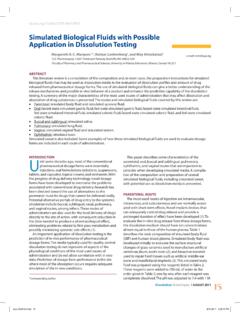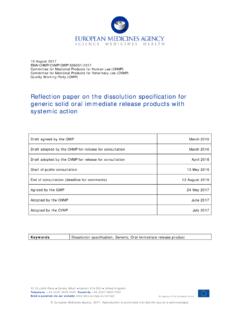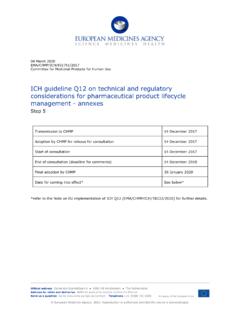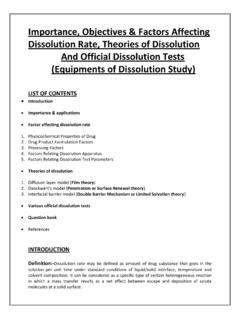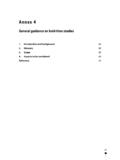Transcription of Discriminatory Dissolution Method Development and ...
1 30 MAY 2016 INTRODUCTIONThe intestinal absorption of drug from a dosage form after oral administration constitutes the following sequential processes: (1) release of the drug substance from the drug product; (2) Dissolution , solubilization, or both of the drug; and (3) permeability of the dissolved drug at the site of absorption. Because the first two steps are critical in determining bioavailability, the Development of an appropriate in vitro Dissolution Method is essential in the prediction of in vivo performance (1).In general, Dissolution tests are useful for (1) assessing the characteristics of the active pharmaceutical ingredient (API) such as the particle size and the crystal form; (2) guiding Development of new formulations; (3) assisting in proper formulation selection (selection of excipients) and optimizing the manufacturing process ( , compression forces, equipment) during dosage form optimization; (4) assessing the batch-to-batch quality of a drug product; (5) enabling the comparison of batches obtained from different production sources; (6) comparing new or generic formulations with an existing product; (7) assessing the stability of the drug product, helping in establishment of shelf life.
2 (8) ensuring product quality in the case of certain scale-up and post-approval changes (SUPAC) like manufacturing site changes, increase or decrease of batch size , and small quantitative changes in excipients; (9) providing a basis for achieving an in vitro in vivo correlation (predicting product performance in vivo); and (10) minimizing the need for bioequivalence studies (biowaivers) (2). In particular, Dissolution studies are quite predictive of in vivo performance for insoluble or poorly soluble drugs, where absorption is ( , Biopharmaceutics Classification System [BCS], Class 2 drugs). Furthermore, a Dissolution Method with suitable discriminating power is preferred to indicate any possible changes in the quality of the product before in vivo performance is affected. The Discriminatory power of the Dissolution Method is the ability of the Method to detect changes in drug product performance, generally demonstrated by determining the effect of deliberate changes in the formulation or process on Dissolution characteristics.
3 The systematic Development of a Dissolution Method of a Discriminatory nature is required much earlier than at full-fledged product Development . This enables the formulator to adopt the right approach in finalizing the prototype formula and process for further scale-up. In addition, demonstration of the Discriminatory nature of the Dissolution Method to be used in routine quality control of commercial lots is expected by major regulatory agencies worldwide (3, 4).Etoricoxib (5-chloro-2-(6-methylpyridin-3-yl)-3- (4-methyl sulfonylphenyl)pyridine) is an orally active, selective cyclooxygenase-2 inhibitor (5). It is a widely prescribed anti-inflammatory drug available in tablet strengths of 30, 60, 90, and 120 mg. It is a poorly soluble and highly permeable BCS Class 2 drug (6). The pKa of etoricoxib is , and the drug exhibits pH-dependent solubility ( , high solubility in gastric media [low pH] and decreasing solubility with increasing pH).
4 The presence of bile salts and lecithin in biorelevant media does not appear to Discriminatory Dissolution Method Developmentand Validation of Etoricoxib Tablets Yasvanth Ashokraj*, Atul Daroi, Raja Gupta, Aruna Khanolkar, Amol Kulkarni, Swati Laud, Milind Pokale, Sanjeet Shedge, and Praveen DateCIPLA Ltd, Mumbai, IndiaABSTRACTThe availability of a Discriminatory Dissolution Method for use in either quality control testing or product evaluation in quality by design trials is mandatory for products intended for the developed market. This study demonstrates the systematic Development of a Discriminatory Dissolution Method for etoricoxib, a BCS Class 2 drug exhibiting highly pH-dependent solubility. The pH, speed, and apparatus were simultaneously optimized and tested for Method variability, reproducibility, and robustness. The discriminative power of the developed Method was suitably : Etoricoxib; Dissolution ; Discriminatory ; BCS Class : 2016impact its solubility (6).
5 There is no quality control or Discriminatory Dissolution Method for etoricoxib tablets reported in the literature. Therefore, the aim of the present work was to develop and validate a Discriminatory Dissolution Method for etoricoxib AND METHODSAll solvents used for HPLC analysis were of HPLC grade, and all other chemicals were of analytical reagent grade and were used as received. The following chemicals were used to prepare buffers and HPLC mobile phase: sodium perchlorate monohydrate (Merck, India), acetonitrile (Fisher Scientific, India), methanol (Fisher Scientific, India), sodium acetate trihydrate (Qualigens, India/Merck, India), glacial acetic acid (Fisher Scientific, India), potassium biphthalate (Merck, India), hydrochloric acid (sd Fine chemicals, India), potassium dihydrogen orthophosphate (sd Fine chemicals, India), sodium hydroxide pellets (Merck, India), and potassium chloride (Merck, India).
6 Formulation PreparationFilm-coated tablets of etoricoxib were prepared by two processes using the following excipients: calcium hydrogen phosphate anhydrous, croscarmellose sodium, magnesium stearate, microcrystalline cellulose, and Equilibrium Solubility StudiesEquilibrium solubility at various pHs were determined by the shake-flask Method . Etoricoxib was added to 25 mL of corresponding USP buffer solution (pH , , , , and ) until a heterogeneous system (solid sample and liquid) was achieved. The samples were sonicated for 10 min and placed in a shaker water bath maintained at 37 C after ensuring the presence of excess solid in the sample. The sample was stirred for 24 h to achieve equilibrium, a small quantity (2 mL) was sampled and filtered through a m PVDF filter, and the concentration of etoricoxib was determined by a validated HPLC StudiesAll Dissolution runs were performed on six tablets using USP Apparatus 2 with a medium volume of 900 mL maintained at 37 C unless otherwise indicated.
7 Dissolution profiles were generated by sampling at 5, 10, 15, 20, 30, 45, and 60 min. Additionally, time points at 90 min and infinity (200 rpm for 10 min) were also generated in some profiles. Samples were filtered through m PVDF filters and analyzed for etoricoxib content by a validated HPLC Method . Sample AnalysisSample analysis was performed using a Waters 2695 separation module equipped with a 2487 UV vis detector (Waters Corp., Milford, MA, USA). The validated reversed-phase HPLC Method employed a Hypersil BDS C-18 column (10 cm mm, 3- m particle size ) maintained at 25 C with a mobile phase composed of 10 mM sodium perchlorate monohydrate/acetonitrile (55:45) at a flow rate of mL/min with detection at 235 AND DISCUSSIONM ajor regulatory agencies (3, 4, 7) expect Discriminatory Dissolution methods for the quality control of the pharmaceutical products, especially oral solid dosage forms.
8 A report by Fish et al. (8) outlined a comprehensive Dissolution Method Development strategy to achieve a Discriminatory Method that was elegantly showcased for dasatinib film-coated tablets. Accordingly, the following steps are required for any Discriminatory Dissolution Method Development : (1) set the objective to achieve a Dissolution profile ( , <50% in 15 min and >85% in 30 min); (2) design the experimental flowchart for the Method Development strategy with anticipated results and way-forward actions; (3) systematically optimize and finalize the medium, speed, apparatus, and volume parameters of the Dissolution Method ; (4) demonstrate the Discriminatory nature of the optimized Dissolution Method ; (5) demonstrate reproducibility of results and robustness of the Method , satisfying variability requirements ( , <20% RSD at first sampling point and <10% RSD at other sampling points).
9 In addition, it is desirable to achieve sink condition requirements, where sink conditions occurs when the amount of drug that can be dissolved in the Dissolution medium is three times greater than the amount of drug to be dissolved (2). However, deviation from fulfilling sink conditions is acceptable if the Discriminatory nature of the Dissolution Method is proved satisfactorily (7).Understanding the physicochemical characteristics of the API is a key starting point for any Dissolution Method Development . In particular, information on equilibrium solubility provides quick direction on the selection of a suitable Dissolution medium. The results of the equilibrium solubility studies for etoricoxib demonstrate that its solubility is highly pH-dependent, which is consistent with earlier reports (6). A significant difference in solubility was observed in the pH region of ( , mg/mL at pH and mg/mL at pH ).
10 Solubility decreased further and remained constant ( mg/mL) above pH to the USP (7), it is essential to have a sufficient number of time points to adequately characterize the ascending and plateau phases of Dissolution curves in a 32 MAY 2016dissolution Method . This was considered the primary criterion for the selection of Dissolution conditions during Dissolution Method Development for etoricoxib tablets. The objective was to obtain a profile with <50% drug release in 10 min and >80% drug release in 30 min with reasonable variability at each sampling point. As observed from the solubility data, Dissolution of etoricoxib can be driven predominantly by the pH of the medium. The effect of pH on the Dissolution of etoricoxib tablets using Apparatus 2 at 50 rpm is shown in Figure 1, which shows Dissolution studies performed at pH , , and covering high, mid, and low solubility regions.

